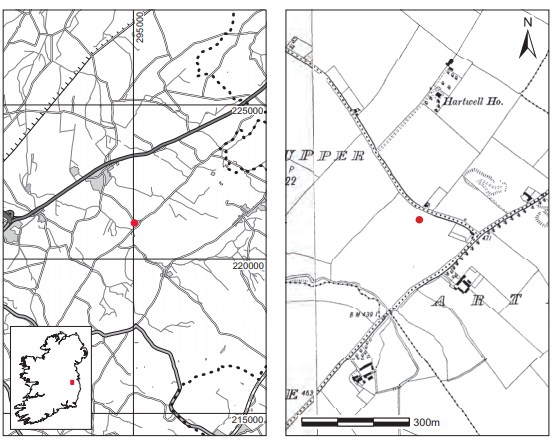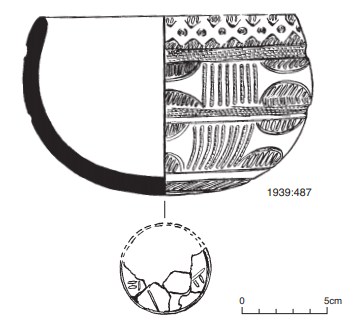County: Kildare Site name: HARTWELL UPPER, CO. KILDARE
Sites and Monuments Record No.: N/A Licence number: —
Author: MAEVE SIKORA
Site type: Early Bronze Age graves
Period/Dating: —
ITM: E 694488m, N 721420m
Latitude, Longitude (decimal degrees): 53.234752, -6.584631
Introduction
In 1936, during digging in a field, a bowl containing ‘ashes, some human teeth and charcoal’ was discovered in a sand ridge near Kill, Co. Kildare. The bowl and its contents were removed from the ground by the workmen, who accidentally broke the bowl. The sherds were given to the local parish priest, Father Byrne, together with some bones, charcoal and an object described as a copper spoon. In April 1939 the discovery came to the attention of officers of the Ordnance Survey working on the revision of County Kildare. The landowner, who was interviewed by Sergeant F.G. Horan of the Ordnance Survey, stated that he never actually saw the vessel as it was taken directly by the workmen to the parish priest.118 Copies of correspondence from Sergeant Horan to the Revision Officer at the Ordnance Survey were provided to the NMI. A short report on the discovery compiled by Sergeant Horan from an interview with Mr Phillip Brady, the finder, records that the ‘urn’ had been found about four years previously while working in a sandpit, the property of Mr Duncan of Hartwell Castle. The vessel was found about ‘18 inches to 2 feet’ under the surface of the ground. It was placed ‘in a grave about six feet by four feet’ with human remains which had a burnt appearance. There is no mention of stones forming a cist, so the nature of the grave is not clear. Following contact from the Museum with Father William O’Farrell, Killashee, the vessel and a small quantity of unburnt human bone (including skull fragments and a mandible; 1939:488–9) were transferred to the possession of the Museum.
Location (Fig. 3.76)
There is confusion on the file regarding the discovery of the ‘urn’, as the find-place is shown in the townland of Hartwell Upper and the find-place of a skull is shown in Hartwell Lower (but neither located in a sandpit or quarry). The OS 6in. sheets 19 and 20 show quarrying activity in Hartwell Lower in fields adjacent to both find-places but do not show any quarry or sandpits in Hartwell Upper. The find-place of a bullaun stone is also shown and referred to in the correspondence. This was located in Hartwell Lower, very close to the site of the discovery of the skull fragments mentioned above. The topographical files and the registers record the vessel from Hartwell Upper and the skull fragments from Hartwell Lower, suggesting that there cannot be any association between the two.


Simple bowl, 1939:487 (Fig. 3.77)
The vessel recovered in 1939 is a simple bowl in fragmentary condition but it has been restored. The rim is slightly inverted but is undecorated. Just below the rim the first panel of decoration is composed of conjoined lozenges formed in false relief. The centre of each lozenge is depressed, and these spaces and the spaces between the lozenges are filled with short vertical strokes. Below is a panel of horizontal impressed lines with comb impressions. Next there is a panel of shapes like stretched hides, formed in false relief and separated by panels of vertical comb-impressed lines. The spaces between the curves are filled with comb-impressed slanted lines. These two latter panels are repeated again. The remainder of the body of the vessel has four impressed grooves of approximately circular form. The spaces between these are plain except between rows two and three, which are filled with short impressed slanted lines. The base is incomplete but shows some evidence of grooved decoration. Dimensions: H 9.95cm; ext. D rim 15.2cm; int. D rim 13.35; D base c. 6cm.
Comment
A sample of the unburnt human remains was dated to 935±35 BP.119 This date is far too late for a skeleton in a primary association with a vessel of bowl type. According to the laboratory at Groningen, the carbon content was within the normal range expected and there was no reason to be suspicious of the date of the sample. The conclusion that must be drawn is that the bowl and the unburnt bones have no link or connection to one another and that another burial must have been disturbed at some point close to the site of the discovery of the bullaun, the presence of which may indicate an early medieval church site. The record, though scant, suggests that the contents of the bowl were in the form of ashes (a term often used to describe cremated bone), teeth and charcoal. It is also recorded on the file that the finder reburied bone which had remained in the grave ‘somewhere nearby’.
HUMAN REMAINS
LAUREEN BUCKLEY
Description of remains (1939:488–9)
Two fragments of adult skull were present, one a fragment of the left parietal bone from near the sagittal suture, and the other a fragment of the left side of the frontal bone from near the left orbit. The supraorbital ridges were not well developed so this may have been a female individual. A juvenile mandible and one rib fragment were also present.
Dentition
Adult dentition
Two adult teeth, the upper left and right first molars, 16 and 26, were also present. There was very little wear on the right molar but moderate wear on the left molar. The left molar also had a small carious cavity on the distal side of the crown.
Juvenile dentition

The crowns of the second molars were not completely formed. A juvenile with this state of dental development would be aged 5–7 years. There seemed to be some crowding in the mandible; a slight area of alveolus had broken away, so that the crowns of 31 and 41 were visible and the tips of the crowns were crossing.
Summary and conclusions
There is very little information about the recovery of these remains and about the nature of the grave. Very little bone was retained and it seems that there was at least one adult, possibly female, and one juvenile aged 5–7 years.
118. Father Byrne had since died and his successor, Father William O’Farrell, had intended to inform the NMI.
119. GrA-24152.